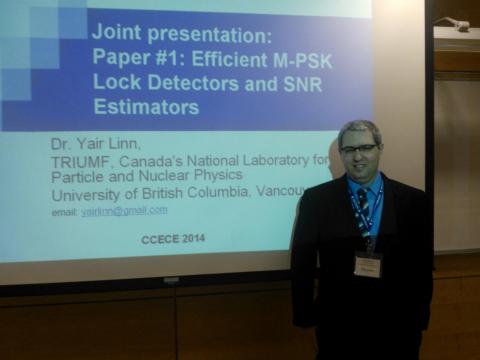

As part of its mission, TRIUMF supports engineering research and technical developments inspired by its pursuit of discovery science in subatomic physics. For instance, the data communication and processing protocols from cutting-edge physics experiments often exploit or even extend the latest developments in wireless communications. Dr. Yair Linn from the Electronics Development Group in TRIUMF's Engineering Division is no stranger to this dual-hatted experience. He recently represented TRIUMF's efforts at an IEEE Canada conference on these topics.
From May 4 to May 7, 2014, Linn attended the CCECE 2014 conference (Canadian Conference on Electrical and Computer Engineering) in Toronto, the flagship annual conference of IEEE Canada, where he presented two papers on wireless communications. The first of those papers, titled "Efficient M-PSK Lock Detectors and SNR Estimators", presented new and efficient structures for lock detection and Signal-to-Noise Ratio estimation in wireless receivers. The second paper, titled "New Structures for Modulation Classification and SNR Estimation with Applications to Cognitive Radio and Software Defined Radio", extends the ideas of the first paper by describing a technique for joint modulation classification and Signal-to-Noise Ratio estimation in wireless receivers. In particular, usage of this technique in "autonomous" or "smart" wireless receivers could allow them to intelligently modify their communication system modulation and parameters, and thus make their communications faster, more energy efficient, and help their batteries last longer.
The innovations described in the papers presented by Linn at CCECE 2014 can be used by billions of wireless devices around the world, such as those found in cellphones, laptops, and tablets --- as well as by several emerging subatomic physics experiments that TRIUMF is supporting.
In addition to the paper presentations, Linn chaired a session at the conference titled "Enabling Communication Technologies", in which papers regarding cutting-edge communication techniques were presented.
Dr. Linn would like to thank TRIUMF, Remy J. Dawson (Division Head - Engineering), Don Dale (Manager, Electronics & Controls), and Daryl P. Bishop (Group Leader, Electronics Development) for support and guidance.
-- T.I. Meyer with editorial assistance from Y. Linn
